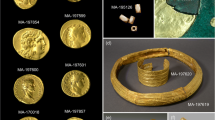Abstract
THE discovery of slightly radioactive silver in the form of the isotopes 108mAg and 110mAg in East European silver bars1 is of considerable interest, because so far as is now known these short-lived radioactive isotopes have not been observed in natural materials2. Lindner et al.1 have given four possible explanations for the presence of the radioactive isotopes, one of which is that the silver ore was mined by an underground nuclear explosion. An alternative natural explanation for the phenomenon seems more probable.
Similar content being viewed by others
References
Lindner, L., Brinkman, G. A., and Schimmel, A., Nature, 240, 463 (1972).
Boyle, R. W., Geol. Surv. Canada Bull., 160, 12 (1968).
Segrè, E., Phys. Rev., 86, 21 (1952).
Littler, D. J., Proc. Phys. Soc. Lond., 65 A, 203 (1952).
Author information
Authors and Affiliations
Rights and permissions
About this article
Cite this article
BOYLE, R. Radioactive Silver in East European Silver Bars. Nature 243, 460–461 (1973). https://doi.org/10.1038/243460b0
Received:
Published:
Issue Date:
DOI: https://doi.org/10.1038/243460b0
- Springer Nature Limited
This article is cited by
-
Nonradioactive silver
Nature (1974)
-
No radioactive silver detectable in silver–uranium ore
Nature (1974)





